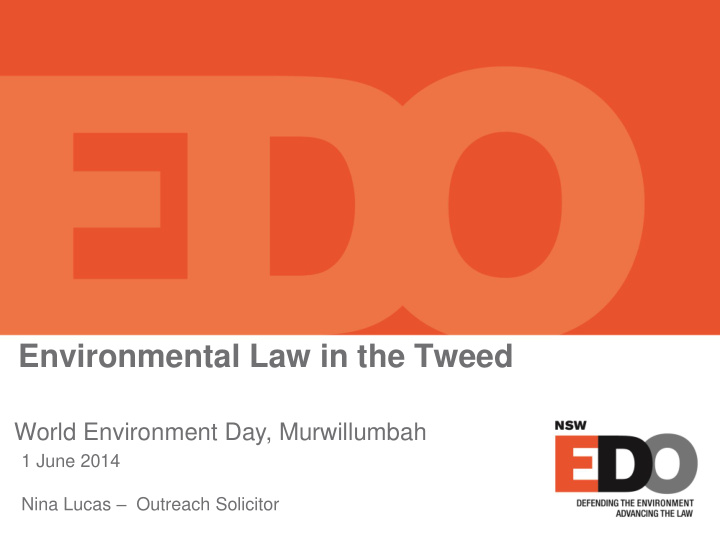



Environmental Law in the Tweed World Environment Day, Murwillumbah 1 June 2014 Nina Lucas – Outreach Solicitor
Presentation overview ● Snapshot: environmental laws in the Tweed ● Local issues: – Illegal land clearing – Northern Councils Environmental Zones Review ● Commenting on Image: Howard Lake decisions & tips on being effective
SNAPSHOT OF ENVIRONMENTAL LAWS IN THE TWEED
Tweed Valley: Biodiversity hotspot Image: Michael Dawes
Layers of environmental laws and regulation • Treaties and Conventions • Convention on World Natural and Cultural Heritage Int • Environment Protection and Biodiversity Conservation Act National • Protection of the Environment (Operations) Act • Environmental Planning and Assessment Act State • Local Environmental Plans • Tweed LEP Local
Tweed Local Environmental Plans
LOCAL ISSUES & EXAMPLES
Vegetation clearing
Vegetation clearing
Vegetation clearing
Enforcement: What you can do ● Monitor vegetation clearing to ensure compliance ● This may require: – Access to approvals – any reports released by the developer – independent evidence to establish a breach (photographs etc.) ● Report breaches to the regulatory authority: – Office of Environment & Heritage (OEH) Environment Line on 131 555 ● Take third party enforcement action
Northern Councils Environmental Zones Review
Northern Councils EZone Review Interim Report – Ezones should only be applied to those areas which have important environmental values – E2 and E3 zoning should only be applied where there is proven evidence of significant environmental values that meet the specific criteria – Land that does not meet the criteria should be zoned according to its primary use
Northern Councils EZone Review Interim Report – Where environmental value is identified which may not warrant an ezone, it should be protected through an environmental overlay on the LEP map e.g. drinking water catchment areas, scenic protection areas, coastal risk areas and terrestrial biodiversity – Extensive agriculture should be permitted without consent on E3 zoned land – Aesthetic values should be removed as an attribute from the E3 zone
Draft recommendations for Tweed LEP 2014 ● Environmental protection zones under Tweed LEP 2000 should be transferred to the E2 zone in Tweed LEP 2014 ● Extensive Agriculture should be prohibited in the E2 zone ● Extensive Agriculture should be permitted without consent in the E3 zone ● Scientific Protection Areas to be included ● Land which was proposed to be zoned E2 or E3 for biodiversity purposes and does not meet the recommended criteria for E2 or E3 zoning, should be zoned according to its primary use.
Northern Councils EZone Review Interim Report • On public exhibition until 5 June 2014
Have Your Say Lodge your submission ● Online: www.planning.nsw.gov.au/proposals ● By post: Director, Planning Coordination and Support Department of Planning & Environment GPO Box 39, Sydney 2001
TIPS FOR COMMENTING ON ENVIRONMENTAL DECISIONS
Advantages of public participation 1. Real environmental outcomes can be achieved 2. The decision benefits from local knowledge 3. Community becomes a key stakeholder (not just industry and government) 4. Public has greater buy-in and ownership of the law or policy objectives 5. Improves transparency and accountability
Writing an effective submission ● Introduce yourself or your group. What is your background and experience? ● Explain why are you interested in and how you will be affected by the reforms or development ● Personalise the submission – it’s OK to sign pro forma submissions, but ensure you personalise it a bit ● Talk about how the proposal will affect – you; – the environment; – the local economy; – social factors.
Writing an effective submission Read proposal and supporting documents Identify key issues/concerns Clearly set out your concerns and support with facts/evidence Tell the decision maker what you want them to do Submit before deadline or request extension
Have Your Say www.edonsw.org.au
MORE INFORMATION
Free initial legal advice, website, fact sheets and updates ● Free Environmental Law Line Monday-Friday – 1800 626 239 ● Fact sheets and other resources ● Free weekly eBulletin – updates on environmental law, policy and decisions
Support our work ● Your support for EDO NSW will help us to: – Provide legal advice and representation; – Promote changes to environmental laws; and – Provide community legal education. ● Donations are tax deductible ● http://www.givenow.com.au/edonsw
Recommend
More recommend